Peaceful War
PEACEFUL WAR
How the Chinese Dream and the American Destiny Create a Pacific New World Order
Foreword by Professor Jack Goldstone
School of Public Policy
George Mason University
A “Pacific” New World Order
The United States welcomes the continuing peaceful rise of China as a world power and that, in fact, it is in the United States’ interest that China continues on the path of success, because we believe that a peaceful and stable and prosperous China is not only good for Chinese but also good for the world and for the United States. President BARACK OBAMA, Sunnylands at Rancho Mirage, California on June 8, 2013
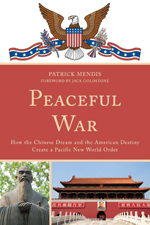 No international relationship is more important to the future of the world—to the prospects for lasting peace and economic prosperity—than that between the United States and China. The United States has been the world’s greatest economic and military power for the last sixty years. But China filled that role for several hundred years prior to the eighteenth century, and is now aiming to recapture its historical supremacy in the economic, cultural, and technological realms.
No international relationship is more important to the future of the world—to the prospects for lasting peace and economic prosperity—than that between the United States and China. The United States has been the world’s greatest economic and military power for the last sixty years. But China filled that role for several hundred years prior to the eighteenth century, and is now aiming to recapture its historical supremacy in the economic, cultural, and technological realms.
Many scholars have attempted to shed light on this relationship, whether from the perspective of great-power rivalry, or China’s recent economic progress, or American decline. Yet none of these approaches fully captures the history and cultural identity of these two nations, or their long relationship.
Patrick Mendis, an award-winning public servant and acclaimed author, was born in Sri Lanka, where Chinese and Western influences have met since the sixteenth century. Educated in the British and American systems, he has served the U.S. Senate Foreign Relations Committee and in various agencies of the U.S. government. From his early youth, living in a UNESCO World Heritage Site in his native land, he has risen to become a commissioner of the United States National Commission for UNESCO—an appointment made by former Secretary of State Hillary Clinton and the White House. Mendis has also taught at several major universities in the United States and China, and traveled extensively throughout the United States, Europe, and Asia. With this rich diversity of experiences, he is ideally situated to bring a fresh perspective to this pivotal relationship, capable of looking at two countries as both an insider and an outsider.
THE VISION THING
Mendis takes us deeply into the roots of Chinese and American cultures. America considers itself an exceptional nation in world history; but so too do the Chinese. America is built on a vision, on an “American Dream” of equality, freedom, and growing prosperity for all. China is also built on a vision, or rather a blend of two visions: the Confucian ideal of a harmonious society ruled by virtue, and the Communist ideal of a vanguard party that leads China into the modern industrialized world. Mendis illustrates how the American and Chinese visions powerfully shape both foreign and domestic policy; indeed they shape the way each nation sees itself and its relation to others.
The United States has offered its vision to the world as the “Washington Consensus” based on free markets and liberal politics. China too has offered its vision globally, as a “Beijing Consensus,” in which strong central government, development planning, and an emphasis on a stable and orderly society are more important than democratic freedoms.
In which direction will the world turn? Mendis asserts that China will have to move toward embracing the American dream—because that is what the Chinese people are coming to demand. Quoting Thomas Jefferson, Mendis observes that “Human nature is the same on every side of the Atlantic [and the Pacific] and will be alike influenced by the same causes.” Noting that people everywhere, once they have a basic level of security, want accountable government and personal freedom, Mendis boldly predicts that “sooner or later, if left unaddressed, this natural human tendency will undermine the entire CPC [Communist Party of China] pyramid like a chamber of magma lying beneath a mammoth volcano.”
In my view, it is also an economic imperative for China to undergo political change. If China is to move to the next stage of economic development, it will need to reward creativity, originality, and innovation. Yet it is difficult, if not impossible, to reward these qualities in the context of tight central controls on information and communication. Innovative thinking emerges more easily and naturally in a free and open society.
Nonetheless, even if China develops western-style democracy, it will be a democracy with distinctive Chinese characteristics—what Mendis cleverly describes as “rewriting the American Dream in Chinese characters.” Moreover, the translation will not come all at once, as at present America and China are in competition everywhere—geopolitically, economically, and ideologically. Beijing is investing heavily in Africa, south Asia, Latin America, and even in America’s own backyard in the Caribbean. Mendis views this as the subtle application of a Monroe Doctrine-like approach by China. At the same time, America has declared a “pivot to Asia,” strengthening its commitment and cooperation with Japan, South Korea, Taiwan, building ties to new (Vietnam) and old (the Philippines) allies in the region, and seeking to play a strategic role in managing conflicts in the South China Sea and throughout the western Pacific.
A BUDDHIST CONNECTION
Mendis illustrates an interesting development in his native Sri Lanka. In the days of Imperial China, Sri Lanka was famed as the “crown jewel” in the Chinese string of pearls naval strategy to secure China’s access to the Indian Ocean. It was a port of special interest to the Ming Admiral Zheng He, an imperial envoy to this Buddhist nation during his voyages across the Indian Ocean between 1405 and 1433. Although after World War II, Sri Lanka was a pro-American parliamentary democracy, the Buddhist country is now a satellite state for Beijing with increasing infrastructure investment, economic interest, and Chinese access to Colombo harbor and the newly-built Hambantota deep-water seaport. Mendis reveals China’s innocuous Buddhist diplomacy, harking back to the religious ties that had linked both countries for millennia, as a shrewd strategy in the region to counter the maritime interests of India and the United States.
Although China professes to be pursuing a “Peaceful Rise,” China’s pursuit of its strategic interests in the Indian Ocean, Africa, and the South China Sea, and its ethos of historical supremacy and Confucian superiority, are fanning the flames of nationalism and creating risks of conflicts abroad. Yet drawing on his longer-term historical perspective, Mendis is optimistic that China and America will avoid overt conflict. Instead, he foresees a “Peaceful War” of ideas and positional maneuvering between these great powers. Mendis describes this possible scenario as “the presence of force without war.” Somewhat like the Cold War, it will involve competition for global influence between major powers; but unlike America and the Soviet Union in the Cold War, China and the U.S. will remain major trading partners for their mutual economic prosperity. The Chinese and American people, too, will continue to trade in ideas, practices, and knowledge. Mendis, for example, predicts that Chinese students in American colleges and universities (over 723,000 enrolled in the 2010-2011 academic year) will return to China as “missiles of freedom” from liberal U.S. institutions. This is a distinctive feature of Sino-American relations, quite different from the Soviet era.
Moreover, given the demographic issues facing China (an aging and shrinking labor force) and the fiscal issues facing the U.S. (the need to bring down a massive level of government debt), both countries will benefit from cooperation and seeking win-win solutions. Mendis explains that the potential for a “social cliff” in China and a “fiscal cliff” in America will inevitably force both nations to find creative solutions for their domestic challenges as a prime national security issue.
A “PACIFIC” DREAM
Using the past as a prism to see into the future, Mendis traces the history of U.S.-Chinese relations back to colonial America, and lays out America’s long-standing love affair with China and things Chinese. His research shows that the relationship between these two countries has always been important and evolving for mutual benefit. Mendis notes the risks involved when American belief in its own manifest destiny confronts a China whose “Chinese Dream” is to again be the world’s dominant nation. Nonetheless, Mendis argues that their “Peaceful War” will lead to the birth of a new “Pacific” New World Order, in which both countries cooperate for the sake of trade, economic growth, and regional stability.
I know of no better guide to the multi-faceted relationship between America and China, and its likely evolution in the coming decades, than this book. The author takes the reader on wonderfully rich voyages, back and forth over the Pacific, the Indian Ocean, and the South China Sea—and across time. Throughout, Mendis is a superbly engaging, erudite, and thoughtful guide.
At a time when both America and China are engulfed in anxiety about the relations between themselves and among their allies, Patrick Mendis offers a much needed and timely antidote to prevailing pessimism. I genuinely hope that leaders on both sides of the Pacific will read and pay attention to the innovative and inspiring ideas in this book; they point the way to a better future for all of us.
 Professor Jack A. Goldstone
Professor Jack A. Goldstone
Virginia E. and John T. Hazel, Jr. Professor of Public Policy
George Mason University
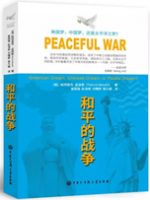
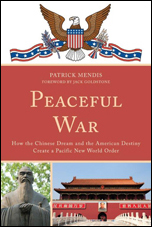 Peaceful War
Peaceful War
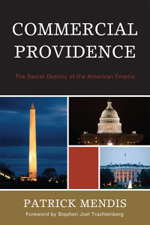 Commercial Providence
Commercial Providence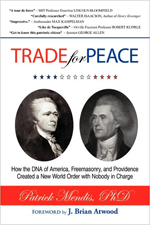 Trade for Peace
Trade for Peace
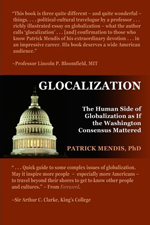 Glocalization
Glocalization